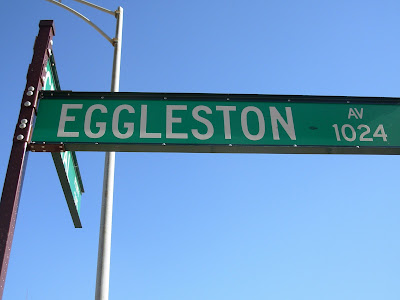Behind the Asphalt is Queen City Survey’s periodic look (and rip-off of VH1’s Behind the Music) at the people behind the names of our city streets.
.jpg)
Benjamin Eggleston was born in Corinth, New York in 1816. He makes his way to Ohio in 1831, eventually settling in Cincinnati in 1845. He becomes involved in the pork-packing industry, eventually joining the firm James Wilson & Co. It is commonly held knowledge that Henry Ford got his idea for the assembly line from the disassembly lines of the slaughterhouses of Chicago. What you may not know is that it was James Wilson and Benjamin Eggleston who invented the disassembly line here in Cincinnati where a "mechanical system that transported hanging carcasses from one butcher to the next" allowed individual workers to remove a particular cut of meat from the carcass as it moved along. In 1867, Wilson dies and the firm is reorganized with Wilson’s sons and named Wilson, Eggleston & Co. Their company was located around what is now Eggleston & Broadway in the historic center of Cincinnati’s early meatpacking district in the Deer Creek Valley.
But that is not how the street got its name.
In addition to Eggleston’s business interests, he was a civic minded individual. A Republican, he was a member of Cincinnati City Council both in the late 1850’s and beginning again 1n 1875, a delegate to the Republican National Convention in 1860, a Ohio State senator from 1862 – 1865 and 1880 – 1881, and a US Representative in Congress from 1865 – 1869. He ran unsuccessfully for Congress a few other times including the election of 1868 and 1872. In 1872 Eggleston was the candidate from the 1st District and Rutherford B. Hayes was the candidate from the 2nd District. They both lost in a wave of local anti-Republican voting. While he and Hayes served together in the Congress from 1865 – 1867, they often traveled together as noted in Hayes’s online diary at the Rutherford B. Hayes Presidential Center.
It was through his efforts as a State Senator that Eggleston Avenue was named after him. As most know, the Miami & Erie Canal travelled a path through Cincinnati that is now Central Parkway and then south what is now Eggleston to the Ohio River. This section of the canal, completed in 1833, included 10 locks. But because of silting of the lower locks due to flooding and high water, this section was rarely used. It became easier to unload at the Lockport and later Cheapside basins (where canal boats would also turn around) and transport product via wagon to the River. Eggleston as State Senator pushes through legislation to sell the canal right of way (the Canal being owned by the State) below Broadway to the City of Cincinnati for the development of a street. The City then names the new street after Senator Eggleston which was suggested by the legislature.
Benjamin Eggleston was also involved in the newspaper business becoming associated with the Cincinnati Chronicle and then the Cincinnati Times. (I do not know his precise dates of involvement). He died in Cincinnati on February 9, 1888, and was buried in Spring Grove Cemetery Section 42, Lot 104.
.jpg)
The once bustling and industrial section of town around Eggleston Avenue is now basically devoid of much of anything. I can’t think of one building with an Eggleston Avenue address. It basically is a quick vehicular bypass along the eastern edge of downtown.
Gilbert Avenue Viaduct over Eggleston and the Deer Creek Valley
.jpg)
.jpg)

Note: This section of Eggleston from Central Parkway to Broadway never really existed originally. Notice the right-of-way and the alignment is slightly different..jpg)
.jpg)
Mt. Adams Incline Monument.jpg)
.jpg)
.jpg)
.jpg)
References:
Historic photos from Library's Cincinnati Memory Project.
Photo of Benjamin Eggleston from Old-Picture.com
"American Heritage of Invention & Technology" Winter 2004, Volume 19, #3
The Biographical Encyclopædia of Ohio of the Nineteenth Century
Man, I love reading this much stuff that I didn't know. Great entry.
ReplyDeleteThe AIA contributed the landscaping of Eggleston as the architects' bicentennial gift to the city in 1988, creating a handsome approach to the Bicentennial Commons.
You're right, it would be a lot more handsome with some more buildings. It's really a missed opportunity.
I agree - great entry!
ReplyDeleteThis is my favorite series, I think.
ReplyDeleteMan, I have walked down Eggleston to Sawyer Point so many times, and I have never noticed that Mt. Adams Incline Monument.
Ditto about the monument.
ReplyDeleteI usually run down Eggleston to the River but usually on the other side of the street. Next time I'll be looking for it.